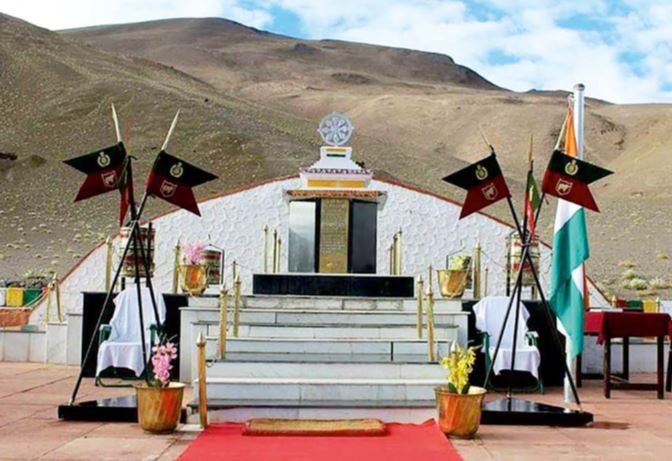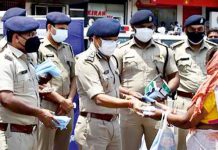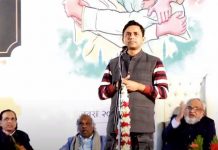
It was in 1959, when its act of valour and sacrifice, the CRPF immortalised itself in the history of the Indian Police.

The Central Reserve Police Force (CRPF) is the premier central police force of the Union of India for internal security. Originally constituted as the Crown Representative’s Police in 1939, the force was raised as a sequel to the political unrest to help native States preserve law and order as a part of the imperial policy. Post-Independence, Sardar Vallabhbhai Patel, the then Home Minister, visualising a multi-dimensional role for it in tune with the changing needs of a newly independent nation, rechristened it as the Central Reserve Police by an Act passed by the Constituent Assembly in 1949. Ever since its inception, the Force has lived up to the expectations of the nation. Many times, it was the first responder and also bore the first brunt of attacks by Chinese and Pakistani armies.
 From 1953 onwards, Leh (Ladakh) and its frontier check posts had been entrusted to the CRPF. This was the time when the Indo-China border was not militarised, and the 2500 km Indo-Tibetan border was manned by police personnel of ITBF and CRPF. The only army garrison was in Leh. It was believed that there is no threat from ‘friendly’ China, and ‘military’ danger is only from Pakistan. Hence, brave soldiers of the ever-dependable CRPF were deputed to tame the wilderness of Aksai Chin, which eventually became the fateful ‘Judas Kiss’ by China. These men were logistically not equipped to fight icy cold winds, inhospitable terrain, lack of oxygen, lack of connectivity, but with sheer determination, they established posts on these locations and would patrol the region.
From 1953 onwards, Leh (Ladakh) and its frontier check posts had been entrusted to the CRPF. This was the time when the Indo-China border was not militarised, and the 2500 km Indo-Tibetan border was manned by police personnel of ITBF and CRPF. The only army garrison was in Leh. It was believed that there is no threat from ‘friendly’ China, and ‘military’ danger is only from Pakistan. Hence, brave soldiers of the ever-dependable CRPF were deputed to tame the wilderness of Aksai Chin, which eventually became the fateful ‘Judas Kiss’ by China. These men were logistically not equipped to fight icy cold winds, inhospitable terrain, lack of oxygen, lack of connectivity, but with sheer determination, they established posts on these locations and would patrol the region.
During this time, China completed the construction of a strategic highway through a traditional caravan route passing from Sinkiang to Tibet via Aksai Chin. Not only did they publicly announce the completion of the highway in 1957, but The People’s Daily, in October 1959, published a map of the region showing Aksai Chin as Chinese territory. In early September of 1959, a patrol party of Indian soldiers was captured east of Chushul by the Chinese and released at the beginning of October. PLA also moved in and established itself, which was evident with the Chushul incident in September.
The only units available for the Indian Government to use to project force quickly were the IBTF (Indian Border Task Force) and the CRPF (Central Reserve Police Force) units in the area.
As a response from the Indian side, the MHA on September 22, 1959, trusting the unflinching dedication of the Force, ordered its deployment to establish posts right on the line where the Chinese presence was registered. For all intents and purposes, the jurisdiction of the operation was given to the IBTF units under DSP Karam Singh and a force of 40 CRPF personnel were deputed to the IBTF under DSP S.P. Tyagi. The first outpost was supposed to be at a place called Hot Springs.
After the post was established by the CRPF on October 20, 1959, three reconnaissance parties were launched from Hot Springs in North Eastern Ladakh in preparation for further movement of an Indian expedition which was on its way to Lanak La, a pass located east of Hot Springs. While members of two parties returned to Hot Springs by the afternoon of that day, the third one comprising of two police constables and a porter did not return. Karam Singh sent out a larger team of ten policemen to go out and look for the three lost men who returned at 2300 hours that same night without success. But interestingly, they had discovered hoof prints on the ground which was proof of Chinese soldiers in the area.
Sensing trouble, a rescue mission was mobilised early the next morning (October 21, 1959) in search of the missing personnel. Sh. SP Tyagi, Dy. SP, CRPF and Sh. Karam Singh, DCIO, ITBF led a team of 20 cavalrymen who went searching for their lost party while another  party of 40 men was asked to follow them on foot. After they reached the point of the hoof impressions, they dismounted and awaited the arrival of the second party. Once the second team arrived, it was decided that Sh. SP Tyagi, Dy. SP, would stay behind and command this larger force while Sh. Karam Singh and his small group of 20 would follow the tracks and see if they led to the Chinese intruders in that sector. However, the two teams lost contact when the first team following the hoof impressions along the banks of the Chang Chenmo went across a hill. Suddenly, a Chinese officer was spotted on this hill overlooking both the teams as he signalled to Sh. Karam Singh to raise their hands and surrender which was befittingly replied. Although the Chinese PLA were at an elevated position in fortified bunkers and trenches, heavily armed and looking down on the exposed police party, our men were unruffled by this show of force. However, when the volley of fire came from the PLA, what took our men with
party of 40 men was asked to follow them on foot. After they reached the point of the hoof impressions, they dismounted and awaited the arrival of the second party. Once the second team arrived, it was decided that Sh. SP Tyagi, Dy. SP, would stay behind and command this larger force while Sh. Karam Singh and his small group of 20 would follow the tracks and see if they led to the Chinese intruders in that sector. However, the two teams lost contact when the first team following the hoof impressions along the banks of the Chang Chenmo went across a hill. Suddenly, a Chinese officer was spotted on this hill overlooking both the teams as he signalled to Sh. Karam Singh to raise their hands and surrender which was befittingly replied. Although the Chinese PLA were at an elevated position in fortified bunkers and trenches, heavily armed and looking down on the exposed police party, our men were unruffled by this show of force. However, when the volley of fire came from the PLA, what took our men with  surprise was the fire from an undetected second Chinese party on the hillock on the other side, which effectively squeezed them in the middle of a crossfire ambush. Their bolt action rifles were unable to retaliate to the bursts of the heavy machine guns and mortars of the Chinese. Hence, one of the men, Ali Raza, was tasked by the party commander to inform the other party led by Sh. SP Tyagi, which he did, but the other party was also under heavy fire and was unable to reinforce or counter-ambush. Fighting gallantly, ten men laid down their lives and nine were wounded. Later, one of the injured also succumbed to his injuries. The main force under Sh. SP Tyagi was forced to retreat and their attempts to recover the bodies of the dead CRPF men later in the night went in vain since many of the men under his command had been wounded and the Chinese still dominated the hill above the riverbank.
surprise was the fire from an undetected second Chinese party on the hillock on the other side, which effectively squeezed them in the middle of a crossfire ambush. Their bolt action rifles were unable to retaliate to the bursts of the heavy machine guns and mortars of the Chinese. Hence, one of the men, Ali Raza, was tasked by the party commander to inform the other party led by Sh. SP Tyagi, which he did, but the other party was also under heavy fire and was unable to reinforce or counter-ambush. Fighting gallantly, ten men laid down their lives and nine were wounded. Later, one of the injured also succumbed to his injuries. The main force under Sh. SP Tyagi was forced to retreat and their attempts to recover the bodies of the dead CRPF men later in the night went in vain since many of the men under his command had been wounded and the Chinese still dominated the hill above the riverbank.
Seven men were taken as Prisoners of War by the PLA, which the Chinese Embassy in Delhi informed the MEA through a note. Post this, as negotiation started through diplomatic channels, the PLA was torturing the captured soldiers to extract as much information as they could. On November 13, the bodies of our martyrs were returned. Only ten police personnel were allowed to collect the sacred remains. Finally, on November 14, the Chinese released all ten men, including Sh. Karam Singh and the initial reconnaissance party of three men held hostage since October 20, 1959.
A life lived for the country is well-lived and it cannot be better exemplified than by the gallant act of the CRPF men who made the supreme sacrifice at Hot Springs.
At 8:00 am on November 14, 1959, the bodies of the CRPF men were cremated with full police honours at Hot Springs. Sh. Karam Singh received a national hero’s welcome and was awarded the President’s Police Medal by the Hon’ble Prime Minister – Pt. Jawaharlal Nehru himself. The Hon’ble Prime Minister, on the occasion of the All India Sports Meet in February 1960, when the CRPF contingent had the privilege of mounting the Guard of Honour to him, at his behest we ‘Reversed arms’ (Reverse arms is a marching movement in which the weapon is held reversed (pointing backwards) as a mark of respect or mourning) to the heroes of Hot Springs.
This event brought together the nation and eventually the long-required change in the security doctrine of the country. The supreme sacrifice by the CRPF personnel during an unmatched battle has made Hot Springs a sacred place of pilgrimage for policemen from all over the country.
 October 21 is befittingly observed as “Police Commemoration Day” to honour the supreme sacrifice by the CRPF personnel that fateful day in 1959 during an unmatched battle. Every year, members of police forces from different parts of the country trek to Hot Springs (now a sacred place of pilgrimage which is currently manned by ITBP) to pay homage to the brave hearts who made the supreme sacrifice that fateful day in 1959.
October 21 is befittingly observed as “Police Commemoration Day” to honour the supreme sacrifice by the CRPF personnel that fateful day in 1959 during an unmatched battle. Every year, members of police forces from different parts of the country trek to Hot Springs (now a sacred place of pilgrimage which is currently manned by ITBP) to pay homage to the brave hearts who made the supreme sacrifice that fateful day in 1959.
The valour of the police jawans fighting at 16,000 ft. altitude in freezing conditions and against a well-equipped and heavily-armed army regiment is a rare saga of courage and commitment to duty. This epitome of rare valour is remembered in reverence and is an everlasting sense of inspiration for all police forces in India, and more so for the CRPF.
Source: The Indian Police Journal













